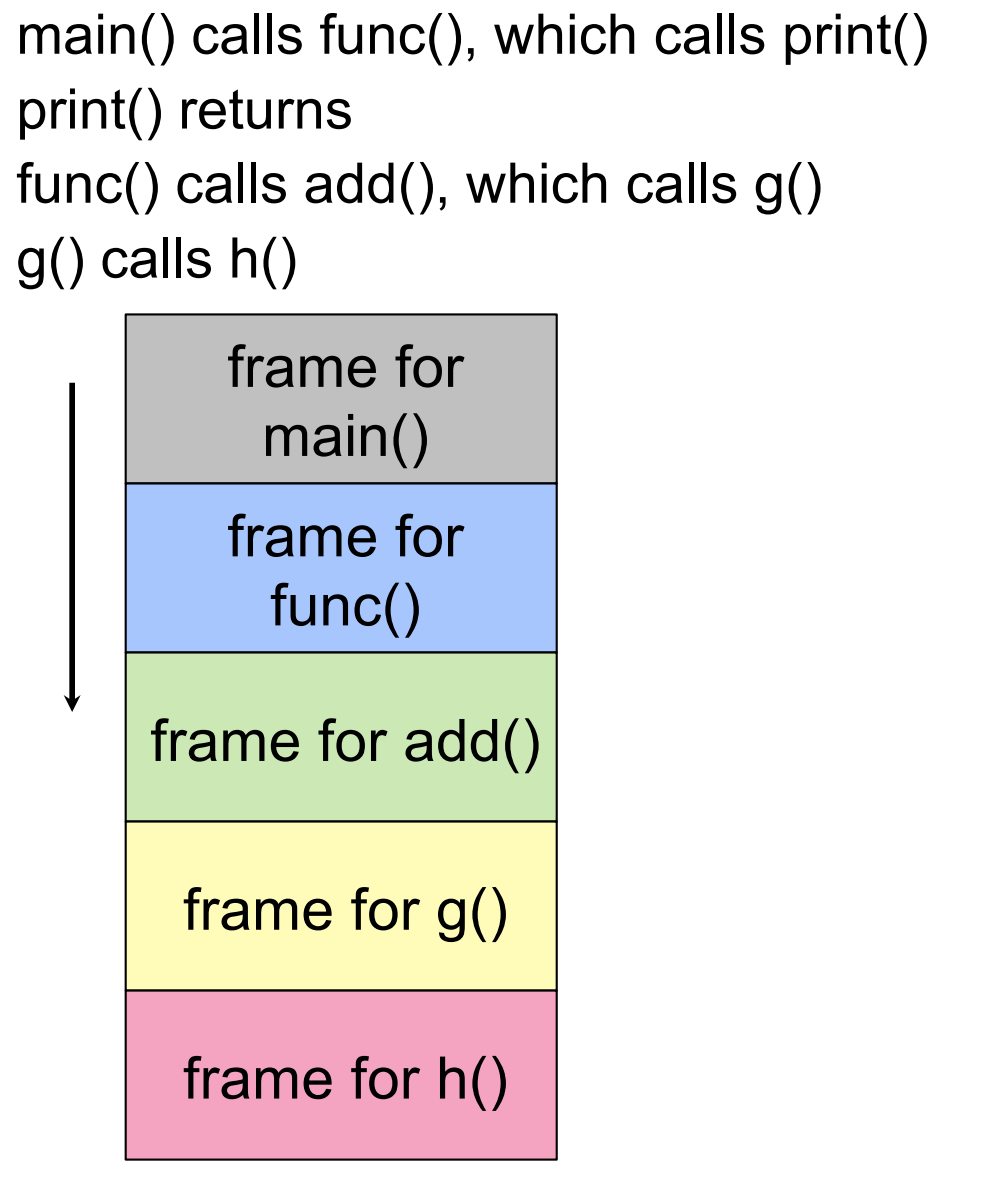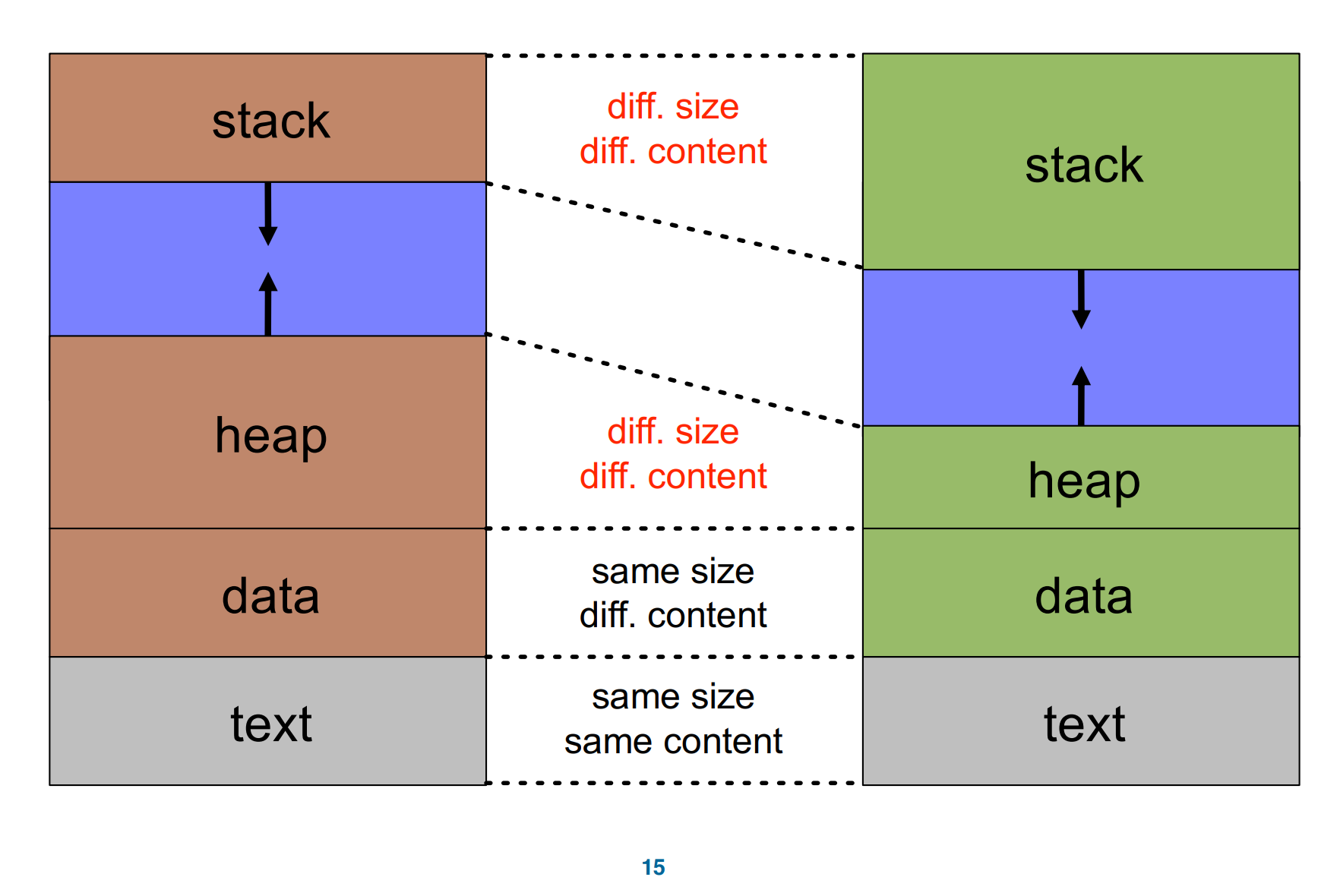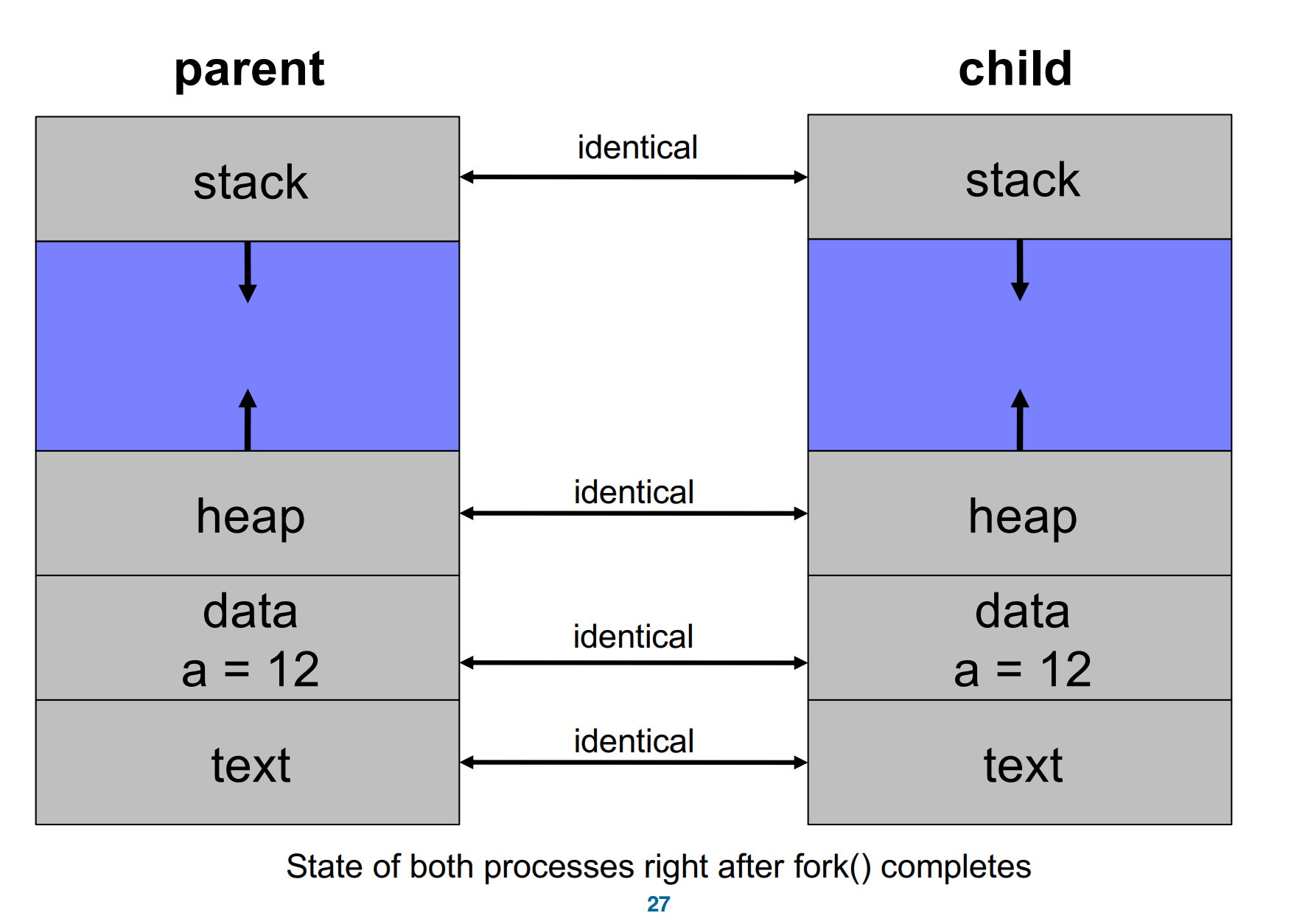Processes¶
Concept¶
-
Process: a unit of resource allocation and protection
-
A process is a program in execution
-
Thread: unit of execution
-
A running system consists of multiple processes
-
Process = 前两项在 ELF 中,堆和栈是运行时的信息在 ELF 之外
ELF编译完成后,里面的.data段就不会变了
- code (text): initially stored on disk in an executable file
- data section: global variables
- program counter: 指向下一条要执行的指令,运行时产生
- processor's registers
- a stack 更快 函数内的临时变量在stack
- a heap: malloc的在heap
The Stack¶
- The runtime stack is
- Items can be pushed or popped
- The items are called activation records(stack frames)
Simple Stack
-
Any function needs to have some state so it can run
-
Parameters passed to it by whatever function called it
-
Local variables
-
The address of the instruction that should be executed once the function
returns: the return address
-
The value that it will return
-
栈从上(高地址)往下(低地址),堆从下往上。如果碰面就发生了溢出(overflow)。
2 processes for the same program
Process Control Block(PCB)¶
-
process metadata
-
Information associated with each process(also called task control block)
- Each process has and only has a PCB, PCB存在内存
- allocate a PCB on new process creation
- free PCB on termination
-
Process state: running, waiting, new, ready, terminated ...
-
Program counter: location of instruction to next execute
- CPU registers: contents of all process-centric registers
- CPU scheduling information: priorities, scheduling queue pointers
- Memory-management information: memory allocated to the process
- Accounting information: CPU used, clock time elapsed since start, time limits
- I/O status information: I/O devices allocated to process, list of open files
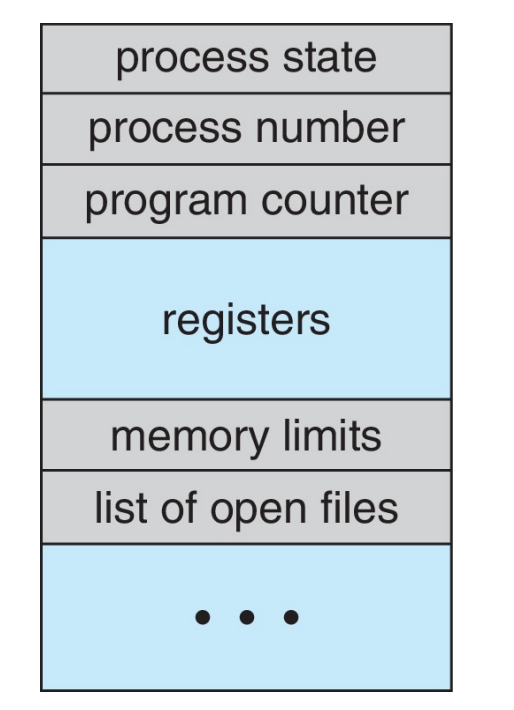
用结构体task_struct,所有可用块用链表连在一起
Process State¶
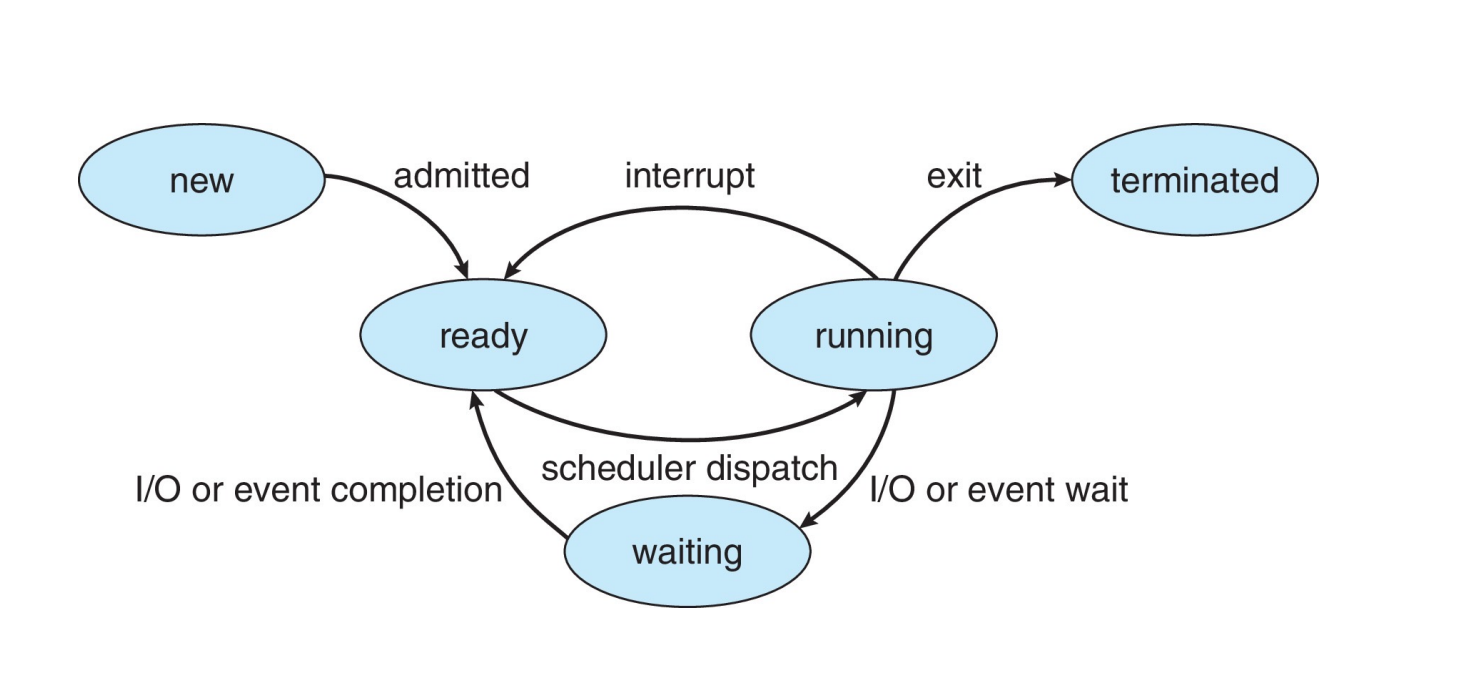
1. Process Creation¶
-
A process may create new processes, becoming a parent
-
process tree

-
pidandppid(parent process id) -
The child may inherit/share some of the resources of its parent, or may have entirely new ones 子进程继承父进程的资源(如打开的文件)
-
A parent can also pass input to a child
-
Upon creation of a child, the parent can either
- continue execution, or
- wait for the child’s completion
- The child could be either
- a clone of the parent (i.e., have a copy of the address space), or
- be an entirely new program
1.1 The fork() System Call¶
fork()creates a new process- child is a copy of the parent, but
pid,ppidare different and resource utilization is set to 0 - return child's
pidto the parent, and 0 to the child getpid(),getppid()- Both processes continue execution after the call to fork()
What does the following code print?
int a = 12; pid = fork(); if (pid) { // PARENT // ask the OS to put me in waiting sleep(10); fprintf(stdout,”a = %d\n”,a); while (1); } else { // CHILD a += 3; while (1); }The answer should be 12.
fork之后变量的值相同,但并不是同一个变量。(相当于一份拷贝)How many times does this code print "hello"?
The answer should be
6times.How many processes does this C program create?
Typical C coding style: call fork() and if its return value is non-zero and do the if clause
int main (int argc, char *arg[]) { fork (); // 2 if (fork ()) { // 4 fork (); // 2 parents fork, 2 childs don't fork, so 4+2=6 } fork (); // 12 }The answer should be 12.
- Address space
- Child duplicate of parent
- Child has a program loaded into it
-
strace无法追踪到fork() -
Pros:
- 简洁:不需要参数
- 分工:
fork搭起骨架、exec赋予灵魂 - 联系:保持进程和进程之间的关系
- Cons:
- 复杂:两个系统调用
- 性能差
- 安全问题
1.2 The execve() System Call¶
execve() system call used after a fork() to replace the process’ memory space with a new program.
execve() 会把之前的进程资源全部丢掉(相当于直接抹掉后面的所有代码),再 load 新的 binary,映射新的内存,分的新的堆和栈,常接在 fork() 后面使用。
execve之后的代码不会执行
Demo
2. Process Terminations¶
A process terminates itself with the exit() system call.
调用 exit 后终止进程,释放资源。
- This call takes as argument an integer that is called the process’s exit/return/error code.
- All resources of a process are deallocated by the OS.
exit终止之后会把资源都释放。 - A process can cause the termination of another process.
- Using something called “signals” and the
kill()system call - A parent can wait for a child to complete.
wait()blocks until any child completes.waitpid()blocks until a specific child completes, can be non-blocking withWNOHANGoptions
2.1 Processes and Signals¶
A process can receive signals. And each signal causes a default behavior in the process.
e.g. 当我们想要终止一个程序时,我们可以敲入 Ctrl+C,这相当于对当前进程发送了 SIGINT 信号,就会终止当前进程。
Manipulating Signals
-
Each signal causes a default behavior in the process
-
The
signal()system call allows a process to specify what action to do on a signal 我们可以修改有些信号的处理程序。 - Signals like
SIGKILLandSIGSTOPcannot be ignored or handled by the user, for security reasons
2.2 Zombie¶
-
When a child process terminates
-
remain as a zombie in an undead state
-
until it is reaped(garbage collected) by the OS 一个进程结束了,但依然还在占用资源
-
child无法自己释放自己的PCB
- A zombie lingers on until
- its parent has called
wait()for the child -
or its parent dies
-
Getting rid of zombies
- child exit时会发送SIGCHLD信号给parent,parent可以添加一个对SIGCHLD的handler并在其中call
wait()
2.3 Orphans¶
- An orphan process is one whose parent has died
- the orphan is adopted by the process with pid 1
-
pid 1 会收养 orphan,因此孤儿进程不会成为 zombie。(pid 1 进程一定会回收子进程)
-
创建一个与当前进程的父进程完全无关的进程:先
fork()一个进程,随后杀死自己,那么当前进程的子进程就会被 pid 1 收养,就脱离了原来的父进程。
3. Process Scheduling¶
- Maintain scheduling queues of processes
- Ready queue: all processes residing in main memory, ready and waiting to execute 只有一个ready queue,且不为空,因为idle一直在里面
- Wait queue: processes waiting for an event 很多个等待队列,一个被等待的事件对应一个等待队列。当我们这个事件到来之时,我们从事件对应的队列选择一个进程。
-
Processes migrate among the various queues.
-
插入一个新的进程,直接通过链表插入,之后减去偏移量后强制类型转换为
task_struct

首先从 ready queue 中拿一个进程去 CPU,
- 如果到时间了(过了一个时间片),就直接把自己放到 ready queue;
- 如果要等待 I/O 事件,就把自己放进 wait queue,等待 I/O 事件发生后再把自己唤醒,放回 ready queue.
- 创建子进程之后子进程放到 ready queue 中,如果调用了
wait,那么父进程等待子进程终止后,进入 ready queue.
3.1 CPU Switch From Process to Process (在这里内容是寄存器)¶
- A context switch occurs when the CPU switches from one process to another

- save old state, load state for the new state
- context of a process represented in the PCB
- context-switch time is overhead 系统在切换时不做useful work
- 调用
switch_to的函数会将return address设置为下一行 - switch中只保存部分寄存器,因为caller寄存器会在调用的时候由调用者保存,只用保存callee即可 - 这些寄存器保存到PCB中作为cpu_context - 内核运行时的内存分布 - kernel态的stack比user态在高地址多了pt_regs,同时kernel栈大小无限 - task_struct里的pc存的是kernel space,pt_regs里的pc存的是user space

- context_switch中涉及寄存器的保存等等是privileged instruction,因此要在kernel mode。对于两个user mode的线程如下。进入kernel mode的时候要先保存user context,存到kernel的栈上,存在
pt_regs区域。
When and where are the context (regs) been saved?
- When: In
context_switch, more specifically, in cpu_switch_to- Where: In PCB, more specifically, in cpu_context
- All regs are running kernel code, termed kernel context

- How does
fork()return new_pid to parent and zero to child - 对parent,相当于一个syscall- 对child,通过pt_regs,pt_regs[0]=0。注意到此时子进程的pc(ARM 里的pc类似于 RISC-V 里的ra,存储返回地址)被设置为了ret_from_fork(调用ret_to_user,再调用kernel_exit),sp被设置为了pt_regs. - 返回两个值,通过两个user context


- When does child process start to run and from where?
- When forked, child is READY à context switch to RUN
- After context switch, run from ret_to_fork
- ret_from_fork -> ret_to_user -> kernel_exit who restores the
